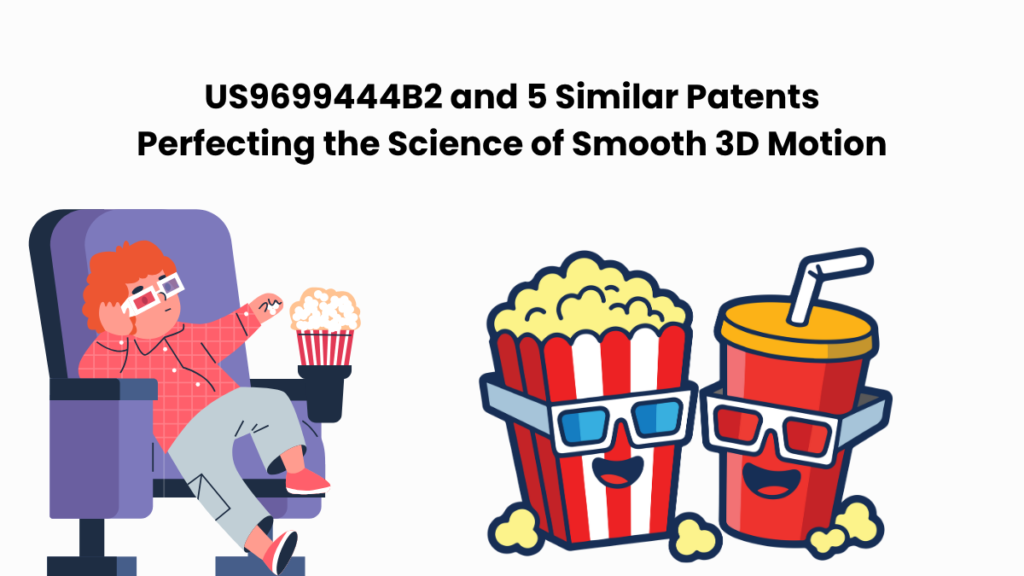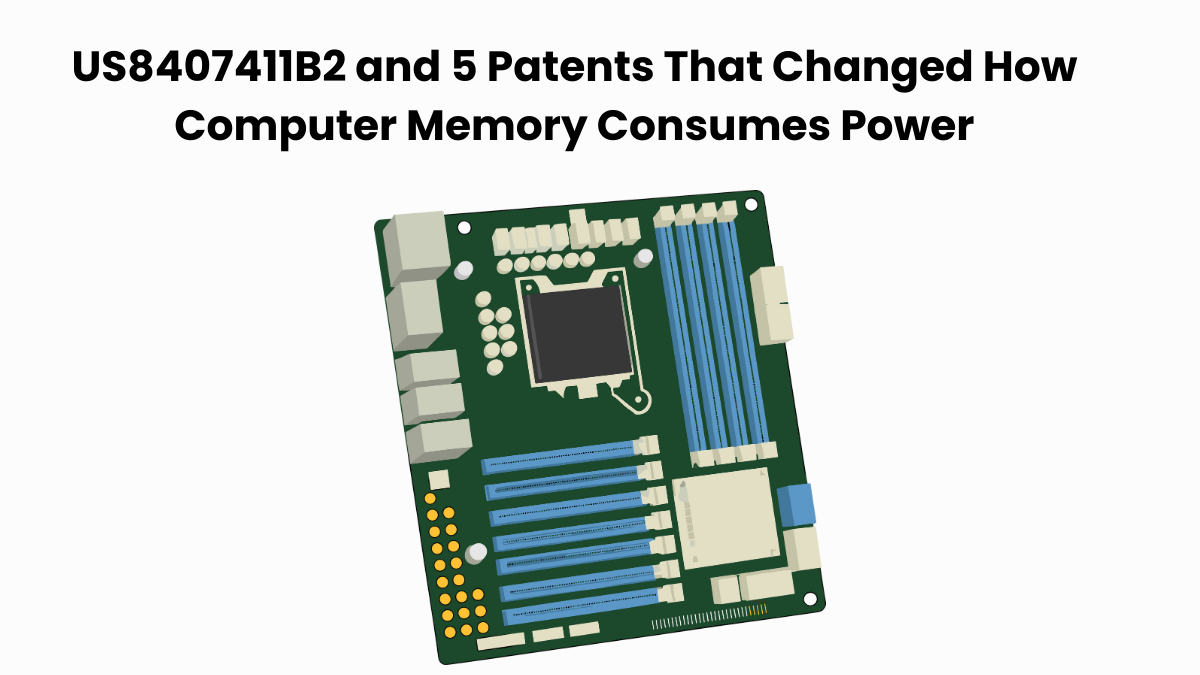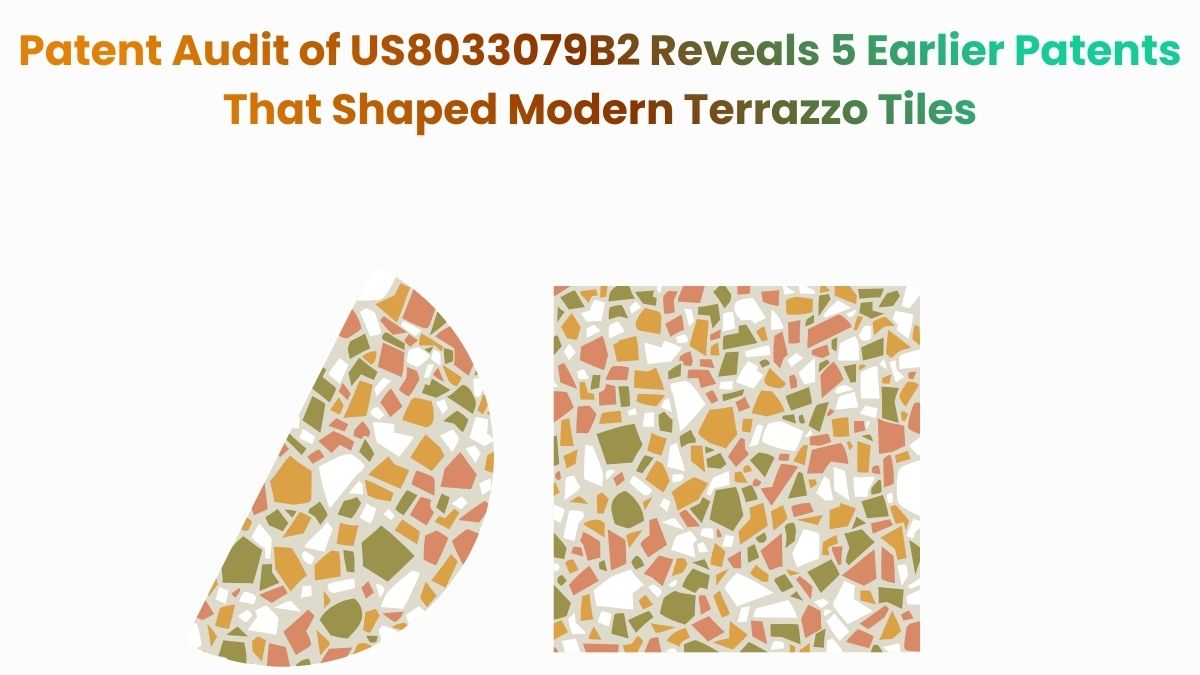Before today’s lifelike 3D visuals, screens often struggled to create a true sense of depth. Movements on screen could feel slightly delayed or disconnected because the lenses in 3D glasses couldn’t adjust fast enough to changes in brightness or motion.
Patent US9699444B2 solved that issue with a smarter lens design. It introduced thin, electronically controlled layers inside the glasses that could darken or lighten almost instantly. Guided by a built-in processor, the lenses adapt in real time to what’s happening on screen, which gives the viewers a smoother, more natural 3D experience.
The patent, which was part of a broader enforcement campaign, reflects the influence of its core technology.
To understand where this invention stands in the broader story of 3D vision landscape, we turned to Global Patent Search (GPS) tool. Let’s see what the tool reveals, but first let’s get to know the patent a bit more.
How Patent US9699444B2 Powers Real-Time 3D Visualization
Patent US9699444B2, titled Faster state transitioning for continuous adjustable 3Deeps filter spectacles using multi-layered variable tint materials, centers around improving how 2D motion pictures are visually transformed into a 3D experience using specialized eyewear.
The invention focuses on faster transitions between lens states (light to dark) by using multiple layers of tint-controllable materials, allowing more precise control over light transmission. This ensures the lenses respond quickly to changes in lateral motion within a video, enhancing the 3D illusion in real time.
What US9699444B2 Covers: Technical Highlights
Here are the key features of this patent:
- Independently controlled lenses: Each lens, left and right, can adjust its brightness separately. This helps the 3D effect stay balanced even when light or movement differs between both sides.
- Layered tint control: Instead of one thick layer, the lenses use several thin layers that darken or lighten faster. This setup reduces delay during transitions and makes the glasses last longer.
- Instant motion response: The lenses react in real time to how fast or bright scenes move on the screen, keeping depth and motion perfectly aligned with what the viewer sees.
- Smooth frame connection: The system adds a short transition frame between two images to make motion feel continuous and natural, thus avoiding flicker or jumpy visuals.
The patent’s broad claims around frame blending, image transformation, and synchronized lens control make it especially potent in litigation involving video processing, image enhancement, or 3D visualization technologies.
Its sweeping applicability across hardware and software platforms, especially in medical imaging and consumer electronics, makes it a prime target for legal challenges and reexamination requests.
A similar emphasis on frame synchronization appears in US7609961B2, which focuses on how integrated camera systems manage timing transitions to maintain visual continuity.
Technologies Advancing Similar 3D Display Concepts
To explore how adaptive 3D visualization evolved beyond the idea in US9699444B2, we used the Global Patent Search (GPS) tool to identify related patents. These references experiment with different ways of controlling light and image transitions in real time.
Let’s explore some of them:
1. US20070133078A1
The patent, US20070133078A1, published on June 14, 2007, and assigned to Saint-Gobain Glass France, discloses a transparent window panel that uses an electrochromic surface element to control light transmission across a field of view. The system includes an electronic control unit that applies voltage to adjust the panel’s opacity.

Source: US20070133078A1
Main Functional Elements of US20070133078A1
Here are the main features of this patent application:
- Smart light control: The glass changes how much light it lets through when electricity is applied, using special materials that can darken or lighten on demand.
- Electronic control system: A built-in control unit manages how the glass switches between clear and tinted states, similar to how a processor adjusts lens behavior in US9699444B2.
- Quick adjustment to input: While it isn’t meant for video, the system can react quickly to changes in electrical signals, showing early progress toward real-time light and tint control.
Shared Technical DNA
Both inventions revolve around controlling how light passes through a surface using electrochromic materials. The 2007 patent from Saint-Gobain applies this principle to large transparent panels that can darken or brighten on command, while US9699444B2 brings the same idea into wearable displays.
In both systems, an electrical signal triggers precise tint adjustments to manage brightness and clarity. The overlap lies in their shared focus on real-time optical modulation through electronically driven light control, which forms the foundation for creating responsive, adaptive viewing environments.
A similar light-modulating approach appears in US9087451B1, where visibility is managed through smart illumination systems that react to environmental cues.
2. CN87210593U
The patent CN87210593U, published on March 23, 1988, introduces photo-sensed discolouration glasses using liquid crystal technology. The invention features a spectacle frame with embedded liquid chips and a central processor to detect light intensity and adjust lens tint accordingly.
Main Functional Elements of CN87210593U
Here are the main features of this patent:
- Built-in processor control: The glasses include small electronic chips and a processor that automatically adjusts how dark or light the lenses appear, depending on the surroundings.
- Light-sensitive lenses: The lenses use liquid crystal materials that respond to sunlight or brightness levels, changing tint to keep vision comfortable.
- Instant light adaptation: The lenses react quickly to shifts in lighting. For example, when moving from indoors to outdoors, showing an early form of real-time lens adjustment similar to what US9699444B2 later achieved.
Technology Overlap of CN87210593U with US9699444B2:
Both inventions address how eyewear can automatically adjust to changing light conditions, but they do so through different means. The 1988 Chinese utility model uses liquid crystal elements and a small processor to sense brightness and modify lens tint, creating glasses that adapt to sunlight in real time.
US9699444B2 takes this adaptive control further, using multi-layered, electronically controlled materials to respond not just to ambient light but to the movement and brightness within dynamic visual content.
The overlap lies in their shared focus on processor-guided tint adjustment, showing an early evolution from light-responsive glasses to the more advanced, motion-synchronized 3D lenses described in US9699444B2.
Motion-processing systems like those described in US8319619B2 rely on similar timing logic to keep recorded movement aligned with rapid scene changes.
3. JPH0943563A
The Japanese Patent JPH0943563A, filed by Canon discloses a video display device as eyeglass-type wearables. The system includes a liquid crystal display unit driven by a microcomputer, allowing video signals to be processed and presented directly on the user’s lenses.
Main Functional Elements of JPH0943563A
Here are the main features of this Japanese patent:
- Built-in video display: These glasses act as small screens, showing video directly in front of the wearer’s eyes, one of the early attempts at wearable displays.
- Processor-controlled visuals: A tiny computer inside the glasses manages how images appear, controlling brightness and timing for smooth playback.
- Direct video playback: The device can receive and display video signals right through the lenses, offering a glimpse of how wearable devices could merge vision and display technology, a concept later refined in US9699444B2.
Part of the Same Vision
Both inventions focus on how visual data can be displayed directly within wearable devices. The 1997 Canon patent introduces eyeglass-type displays that show video content on built-in liquid crystal screens controlled by a microcomputer.
Similarly, US9699444B2 uses processor-driven optical control to adjust lens behavior in real time for a 3D viewing effect. The overlap lies in their shared goal of integrating processing and display mechanisms within eyewear, allowing visual content to adapt instantly to what the user sees.
Where JPH0943563A concentrates on rendering video signals, US9699444B2 expands that idea to dynamically modulate light and depth, pushing the concept of wearable visual technology toward interactive 3D experiences.
Recommended Read: Find how US8108267B2 and Similar Patents enables you to try before you buy furniture or other products through AR and VR.
4. US20100110523A1
US20100110523A1, discloses an automotive rearview mirror assembly utilizing electrochromic technology. The invention describes how polychromic solid films can be controlled via an electronic system to alter reflectivity in response to environmental light.
Main Functional Elements of US20100110523A1
Here are the main features of this patent application:
- Light-adjusting mirror surface: The mirror uses special electrochromic films that darken or brighten automatically when electricity flows through them, helping control glare and reflection.
- Built-in electronic control: A small processor manages how quickly and how much the mirror changes its tint, similar to the control logic seen in US9699444B2’s smart lenses.
- Layered film design: The mirror is made of multiple thin layers that work together to fine-tune how light passes through or reflects, improving visibility without needing any manual adjustment.
Technology Overlap of US20100110523A1 with US9699444B2:
Both patents use electrochromic films to regulate how much light passes through or reflects from a surface.
The 2010 invention applies this to rearview mirrors, adjusting brightness automatically to improve visibility. US9699444B2 builds on the same concept for wearable lenses, using electronic control to manage tint changes in motion.
Their overlap lies in using electrically responsive layers for instant light adjustment, though each serves a different visual context.
5. EP0470867A2
The European patent EP0470867A2, published on February 12, 1992, and assigned to Magna Donnelly Corp, discloses an electrochromic assembly for variable light transmission.
The system relies on the electrical control of electrochromic materials layered within a housing, which adjusts transparency or reflectivity in response to voltage.
Main Functional Elements of EP0470867A2:
Here are the main features of this Europeanpatent
- Smart light control: The system uses electrochromic layers that can change how much light passes through or reflects, helping manage brightness automatically.
- Electronic circuit operation: Electrical circuits control how and when the layers switch between clear and tinted states, similar to the processor logic used in US9699444B2.
- Layered material design: The setup includes multiple thin layers working together to adjust transparency smoothly, forming the base for later innovations in adaptive lenses and smart displays.
Technology Overlap of EP0470867A2 with US9699444B2:
Both patents center on electrochromic systems that change transparency through electrical control. The 1992 patent applies this mechanism to multi-layer assemblies designed for adjustable light transmission in windows or mirrors.
US9699444B2 builds on a similar foundation but adapts it for dynamic lens control in 3D eyewear. Their overlap lies in the use of layered electrochromic materials managed by circuits to achieve smooth, real-time adjustments in light levels across different viewing environments.
How GPS Maps the Broader 3D Visualization Landscape
Understanding how adaptive 3D visualization evolved requires a view of the broader innovation landscape. The Global Patent Search (GPS) tool helps uncover related inventions that explore similar principles of light control, electrochromic materials, and display synchronization.

Here’s how you can explore this technology space using GPS:
- Enter the patent number: Type a number like US9699444B2 into the GPS tool. You can also use keywords such as electrochromic lens, real-time tint adjustment, or 3D visualization.
- Review the snippets: GPS now presents key text snippets instead of full claims. These highlight how other inventions approach challenges in display timing, material response, or image clarity.
- Explore connected innovations: The tool lists patents and non-patent literature working on similar ideas, from smart windows to adaptive eyewear, all focused on responsive light modulation. You can explore them as it is or further sort be relevance if you would like to focus more on patents related to liquic dystal display tevhnology or real-time tint adjustment.
- Compare system logic: GPS lets you see how each patent manages signal processing, material layering, or visual synchronization to achieve seamless optical control through relevant snippets.
- Discover cross-domain insights: By linking technologies across automotive, healthcare, and entertainment, GPS provides a wider perspective on how real-time visual systems are evolving.
Whether you’re exploring display systems or light-responsive materials, Global Patent Search tool helps you uncover meaningful technical insights and spot patterns shaping the next wave of visual technology.
Disclaimer: The information provided in this article is for informational purposes only and should not be considered legal advice. The related patent references mentioned are preliminary results from the Global Patent Search tool and do not guarantee legal significance. For a comprehensive related patent analysis, we recommend conducting a detailed search using GPS or consulting a patent attorney.




